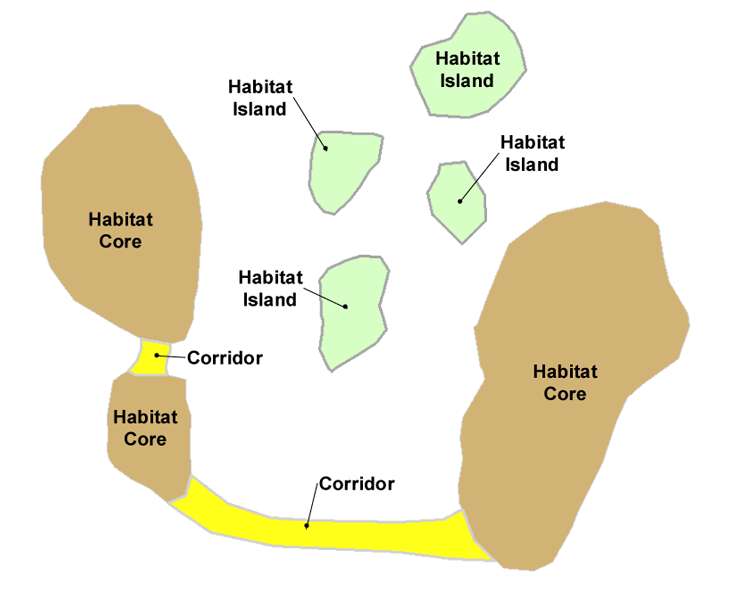III. Decision Support Tool for Habitat Fragmentation Solutions
A. Habitat Fragmentation Background, Concepts and Terminology
Habitat fragmentation refers to the process of severing previously continuous habitat (or ecosystems) into smaller and spatially separated patches of habitat by human-induced and natural processes. (ELI 2003). Causes of habitat fragmentation include land conversion to agriculture, housing and commercial development, natural resource extraction (e.g. mining, forestry, oil/gas recovery), transportation corridors, utility corridors, and natural disturbances like wildfire, wind, or flooding. Fragmentation results in the reduction in the area of natural habitats that can lead to changes in ecosystem functions and wildlife populations. Suburban and rural development commonly change patterns of habitat continuity of natural forests, grasslands, wetlands, and coastal areas as a result of adding fences, roads, houses, landscaping, and other development activities (Dale et al. 2000).
Roadway impacts to the natural environment are well-documented, but it has only been in the last two decades that extensive research into the role of transportation projects on habitat fragmentation and connectivity has been performed. This research has led to a new and growing understanding of both the effects of roadways on landscape processes and larger ecosystems, and methods to assess, minimize and compensate for unavoidable impacts. Habitat fragmentation in general is a threat to biological diversity in the United States (Wilcove et al 1998). For transportation projects, the potential changes, or impacts, to landscapes can vary in significance by project, ecosystem and species. Some of the potential effects of habitat fragmentation include (Gunderson, et al. 2005):
- Reduction in genetic exchange/loss of species population
- Reduction in species diversity/distribution
- Increase in wildlife-vehicle collisions
- Reduction in habitat quality (water quality, noise, plant community change/invasive plants)
- Loss of habitat connectivity
Clevenger and Huijser (2011) provide a concise overview of the mechanisms for these impacts. Key terms and concepts associated with habitat fragmentation which are used in the habitat assessment process and in this decision support tool are explained here since there are several uses of these or similar terms in the practice. Figure 2 also provides a schematic to clarify some habitat fragmentation terms and concepts.
- Connectivity- the degree of connectedness across a defined landscape that facilitates or impedes species movement among terrestrial and aquatic habitats (Taylor et al, 1993; Tischendorf and Fahrig, 2000).
- Patch– a relatively homogeneous type of habitat that is spatially separated from other similar habitat and differs from its surroundings (Forman, 1995; McGarigal and Marks, 1995).
- Core-a patch of habitat which supports a population which can serve as a source for other habitat patches regardless of connectivity (Baur, et al, 1995; Porej et al, 2004).
- Island- a patch of habitat separated by natural or artificial means from other patches of the same habitat (Fernández-Juricic and Jokimäki, 2001; Jennersten et al, 1992).
- Corridor -a land feature that connects core areas allowing species movement and connection between areas of natural habitat enabling the ecological network to function. Corridors can be continuous strips of land or stepping stones that are patches of suitable habitat (Beier and Noss 1988; Bennett, 1990; Forman, 1995; Dramstad et al, 1996; Fischer et al, 2000).
- Landscape Scale - a larger area of land containing a variety of habitat patches or landscape elements which depicts the extent and function of existing networks. A landscape is not necessarily defined by its size; rather, it is defined by an interacting mosaic of patches relevant to the phenomenon under consideration (at any landscape scale) (Forman, 1999; Harris et al, 1996; Turner, 1989).
- Target (focal) species –individual or group of species chosen to represent the movement and habitat needs of wildlife species in the study area. Target species should include: (a) species narrowly dependent on a single habitat type, (b) area sensitive species, and (c) species most sensitive to barriers (Majka, D., J. et al, 2007).
- Habitat Networks or Linkages (Terrestrial/Aquatic) - a functionally interconnected chain of natural habitats across a landscape that contains core areas, corridors, and buffer zones that are relatively close to each other, thereby allowing for the movement of species between and within the network elements (Davidson, 1996; Opdam, 2002; Marcott, 2006; Kallimanis, 2008).
upport Tool for Habitat Fragmentation Solutions
Figure 2 - Conceptual Illustration of Habitat Patches as Cores, Corridors and Islands

The following section provides a framework for assessing habitat fragmentation impacts and mitigation needs for different highway improvement types. Section C provides an overview of the key elements of habitat fragmentation analysis within the context of the NEPA process.